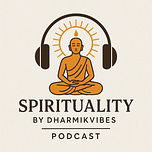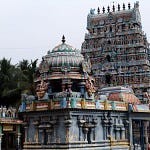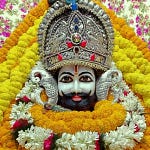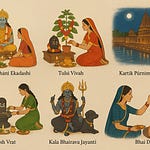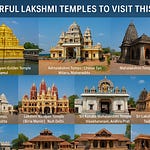The Forgotten Temple Within
Since the beginning of time, human beings have sought to understand the mystery of existence. Who am I? Where did I come from? What is the purpose of life? And above all - where is God?
To answer these questions, civilizations across the world built magnificent temples, pyramids, cathedrals, stupas, and mosques. They crafted idols out of stone and bronze, lit sacred fires, chanted prayers, and offered sacrifices. For millennia, humanity has looked upward to the heavens or outward to holy places, convinced that the divine must dwell far away - in the skies, in sacred rivers, or in sanctified shrines.
But amidst this outward journey, a deeper, quieter truth has always whispered: What if God is not outside, but inside you?
This is not a modern idea. The sages of the Upanishads, thousands of years ago, declared that the ultimate reality - Brahman - is not separate from the inner Self, the Atman. Their mahavakyas (great declarations) shook spiritual thought:
“Aham Brahmasmi” - I am Brahman.
“Tat Tvam Asi” - Thou art That.
These words were revolutionary, suggesting that divinity is not a distant ruler sitting above the clouds, but the very essence of our being. The Bhagavad Gita echoes the same: Krishna tells Arjuna, “I am the Self seated in the hearts of all beings.”
Other traditions, too, have spoken of this inward kingdom. The Buddha taught that liberation is not a gift from outside, but the flowering of one’s own awakened mind. Jain Tirthankaras became divine not by worshiping an external God but by realizing and conquering the Self within. Even Jesus declared, “The Kingdom of God is within you.”
Yet, despite these timeless reminders, humanity continues to forget. We continue to search for God only in temples, churches, and rituals, while neglecting the most sacred temple of all - our own heart. The outward journey is important, but it is incomplete without the inward one. Temples, idols, and scriptures are meant to guide us, but the destination lies within, where silence, awareness, and love reveal the hidden spark of divinity.
This article is an exploration of that forgotten truth. It will journey through the history of spiritual thought, from the Vedas and Upanishads to the Bhagavad Gita and beyond. It will recount stories of seekers and saints like Nachiketa, Prahlada, and Mirabai, who discovered God not in stone but in spirit. It will examine the philosophical schools of Hinduism - Advaita, Dvaita, and Vishishtadvaita - that offer nuanced understandings of the Self and God. It will show how temple architecture, science, psychology, and meditation practices all point toward the same realization: the divine dwells within.
Above all, this is not just a philosophical inquiry but a practical invitation. To see yourself not as small, sinful, or broken, but as a living temple carrying the eternal light. To see others not as strangers or enemies, but as reflections of the same divine essence.
Perhaps the greatest spiritual revolution is not in discovering new gods but in rediscovering the God within.
🌿 Ancient Roots of the Idea: God Within
The idea that divinity is not merely outside but within has appeared in many spiritual traditions, but its most profound articulation arose in ancient India. Here, the sages did not stop at worshiping the forces of nature - they eventually turned their gaze inward and discovered that the ultimate reality was not just beyond the world, but also at the core of the self.
The Vedas and the Upanishads
The Rig Veda, the oldest scripture known to humanity, is filled with hymns to natural deities - Agni (fire), Vayu (wind), Indra (thunder), Surya (sun). These were not seen merely as physical forces, but as manifestations of the divine - accessible, powerful, and awe-inspiring. Worshiping nature was the earliest human attempt to connect with something beyond survival, to touch the sacred.
But as centuries passed, Indian spirituality evolved. The sages of the Upanishads began to ask deeper questions: If the gods pervade all of nature, then who is the seer behind the seeing? Who is the experiencer behind experience? Their meditations shifted focus from outer rituals (karma kanda) to inner inquiry (jnana kanda).
Out of this inner awakening emerged the mahavakyas (great declarations):
“Aham Brahmasmi” - I am Brahman. (Brihadaranyaka Upanishad)
“Tat Tvam Asi” - Thou art That. (Chandogya Upanishad)
“Prajnanam Brahma” - Consciousness is Brahman. (Aitareya Upanishad)
“Ayam Atma Brahma” - This Self is Brahman. (Mandukya Upanishad)
These were not philosophical speculations but experiential truths. They shattered the duality between God and human, between creation and creator. God was no longer a distant ruler in the sky - God was the very essence of the soul, the Atman, identical with Brahman, the infinite.
This inner revolution was India’s greatest spiritual contribution. While many civilizations continued to direct devotion outward, the Upanishadic sages turned the lamp inward and discovered the temple within.
The Bhagavad Gita - God in the Heart
The Bhagavad Gita carries this truth into the heart of human struggle. On the battlefield of Kurukshetra, Arjuna stands paralyzed, unable to fight against his own kin. In this moment of despair, Krishna reveals profound truths about life, duty, and the divine.
Krishna tells him:
“Aham atma gudakesha sarvabhutasaya sthitah”
(I am the Self, O Arjuna, seated in the hearts of all beings.) - Bhagavad Gita 10.20
This is one of the most direct teachings of divine immanence - God resides not in distant heavens, but in the very heart of every living being.
The Gita emphasizes this repeatedly:
6.29 - “The yogi sees the Self in all beings and all beings in the Self.”
15.15 - “I am seated in everyone’s heart; from Me come memory, knowledge, and reason.”
The message is clear - outward worship may begin the journey, but ultimate realization lies within.
Buddhism and Jainism - Liberation Through Self
When the Buddha appeared in India, he challenged the overemphasis on ritual, sacrifice, and dependence on external deities. He did not deny the gods but declared them irrelevant to liberation. True freedom, he taught, comes from inner awakening.
Nirvana is not a reward given by an external power but the natural state revealed when ignorance is destroyed.
The Buddha urged seekers: “Atta deepo bhava” - “Be a lamp unto yourself.”
This was a radical shift - the divine or ultimate truth was to be found in direct experience, within one’s own mind and heart.
Jainism carried a similar vision. The Tirthankaras (spiritual conquerors) achieved divinity not by pleasing gods but by purifying themselves through discipline and inner conquest. Jain philosophy declares:
“The soul itself is God. When freed from all impurities, it shines with divine light.”
Both Buddhism and Jainism moved the axis of divinity inward - from external gods to inner transformation.
Christianity - The Kingdom Within
Christianity too contains a profound teaching of inner divinity, though often overlooked. Jesus said:
“The Kingdom of God is within you.” - Luke 17:21
This statement places the divine not in a faraway heaven but in the immediacy of one’s inner being. The early mystics of Christianity echoed this view. St. Augustine wrote: “God is more inward to me than my innermost self.”
Though later traditions often externalized divinity, these words preserve the radical truth that the divine is already present within each soul.
From the Vedas to the Upanishads, from the Gita to Buddhism, Jainism, and Christianity, one golden thread emerges:
Divinity is not confined to temples, rituals, or distant heavens - it lives within the soul.
Outward worship is a doorway - inward realization is the destination.
The ultimate truth is not about finding God elsewhere - it is awakening to the God that has always been within.
✨ Stories That Illuminate the Truth
Stories often convey spiritual truths more powerfully than dry philosophy. They bring concepts to life, showing how seekers and saints across ages discovered that the divine is not confined to temples or rituals, but resides within. Here are four timeless stories that shine this truth.
1. Nachiketa and Yama – The Boy Who Sought Immortality
In the Katha Upanishad, a young boy named Nachiketa becomes the hero of a profound spiritual dialogue. His father, Vajashrava, while performing a ritual sacrifice, donates old and useless cows instead of healthy ones. Disturbed by this hypocrisy, the boy innocently asks: “Father, to whom will you give me?” Angered, the father blurts out: “I give you to Yama, the Lord of Death!”
Obedient and fearless, Nachiketa travels to the abode of Yama. When he arrives, Yama is away, so the boy waits for three days without food or water. Impressed by his patience and discipline, Yama offers him three boons.
In the first boon, Nachiketa asks for his father’s anger to be calmed.
In the second, he asks to learn the fire-sacrifice that leads to heaven.
For the third boon, he asks the ultimate question: “What happens after death? Does the Self continue or perish?”
Yama tries to dissuade him, offering wealth, pleasures, long life, and kingdoms. But Nachiketa is unmoved. He insists on knowing the eternal truth. Finally, Yama reveals:
“The Self is unborn, eternal, undecaying, and ancient. It is not killed when the body is killed.” – Katha Upanishad (1.2.18)
Yama explains that the Atman (Self) is beyond birth and death, beyond cause and effect, beyond decay. To know this Self is to conquer death itself.
Lesson: The story teaches that true immortality is not found outside but in realizing the Self within, which is untouched by time and death.
2. Adi Shankaracharya’s Wisdom – The Body as a Temple
Adi Shankaracharya, the great philosopher and saint of Advaita Vedanta (non-dualism), traveled across India during the 8th century CE. He saw people engrossed in rituals, worshiping idols mechanically, and debating scriptures endlessly, while forgetting the essence of spirituality.
He reminded them with a powerful verse:
“Deho devalaya prokto, jivo deva sanatanah.”
(The body is a temple, the soul is the eternal deity inside.)
In this vision, the human body itself is the temple, the breath is the lamp, the heart is the sanctum, and the soul (Atman) is the deity. Worship is not complete until one bows to the divinity inside.
Shankara’s message was clear - rituals and temples are valuable, but they are secondary. The highest worship is self-realization, recognizing the eternal Self within.
Lesson: The true temple is not built of stone but made of flesh and spirit. To neglect the inner deity while worshiping outer idols is like polishing the shell while forgetting the pearl inside.
3. Prahlada and His Faith – God Everywhere
One of the most beloved stories from the Bhagavata Purana is the tale of Prahlada, the young devotee of Vishnu. His father, Hiranyakashipu, was a mighty king who had obtained a boon that made him nearly invincible. Proud and arrogant, he declared himself as God and forbade the worship of Vishnu.
But Prahlada, filled with pure devotion, continued to chant “Om Namo Bhagavate Vasudevaya” and worship Vishnu in his heart. Enraged, Hiranyakashipu tried to kill him in many ways - throwing him into fire, casting him into the ocean, trampling him with elephants, poisoning his food - but Prahlada remained unharmed, protected by his unwavering faith.
Finally, Hiranyakashipu asked him mockingly: “Where is your God now? Is He in this pillar?” Prahlada calmly answered: “Yes, He is everywhere.”
At that moment, Vishnu manifested as Narasimha - half man, half lion - bursting forth from the pillar. He killed Hiranyakashipu at twilight, on the threshold (neither inside nor outside), with his claws (neither weapon nor non-weapon), fulfilling the conditions of the boon.
Lesson: Prahlada’s story teaches that God is not confined to idols, temples, or rituals. His presence pervades everything, everywhere - and most importantly, He lives within the heart of the devotee who surrenders in love.
4. Mirabai’s Surrender – The Inner Companion
Mirabai, the 16th-century saint and poetess, is one of the shining lights of the Bhakti movement. Born a Rajput princess, she was married into the royal family of Mewar. But her heart belonged not to palaces or politics, but to Krishna, whom she loved as her eternal Lord and companion.
She sang:
“Mere to Giridhar Gopal, doosaro na koi.”
(Krishna is mine, no one else is mine.)
Mirabai’s devotion was not ritualistic but deeply personal. For her, Krishna was not just an idol in the temple - He was her beloved within her heart, her constant inner presence. Even when she faced opposition, threats, and attempts to poison her, her love for Krishna never wavered. She danced and sang in ecstasy, lost in the divine within.
She declared: “My Lord lives in my heart, how can I ever be apart from Him?”
Lesson: Mirabai’s life shows that true devotion dissolves the boundary between self and God. When love is pure, God is no longer outside - He becomes the soul’s inner companion, inseparable and eternal.
Nachiketa shows us that the Self is immortal and already within us.
Shankara reminds us that the body is the temple and the soul the true deity.
Prahlada demonstrates that God pervades everything, and faith awakens His presence everywhere.
Mirabai reveals that true devotion makes God your inner companion, always within.
Each of these stories carries the same truth in different forms - the divine is not elsewhere, but within.
Schools of Thought: How Philosophy Explains Inner Divinity
Indian philosophy is unique in its depth and diversity. Over thousands of years, sages and philosophers developed different schools of thought, each seeking to answer the same timeless question - What is the relationship between the individual soul and the supreme reality? Though they sometimes disagreed in method or conclusion, all pointed toward the truth that divinity is not merely outside, but intimately connected with the self.
Advaita Vedanta - Oneness
Advaita Vedanta, founded by Adi Shankaracharya in the 8th century CE, is the philosophy of non-dualism. It declares boldly:
Atman (the individual self) and Brahman (the supreme reality) are one.
Separation is Maya - an illusion created by ignorance.
Liberation (moksha) comes when one realizes: “Aham Brahmasmi” - I am Brahman.
In this vision, there is no real distinction between God and the individual. Just as space inside a pot is not different from the vast space outside, the soul inside the body is not different from Brahman, the infinite consciousness.
Advaita emphasizes self-inquiry: “Who am I?” When one pierces beyond body, mind, and ego, only pure awareness remains - that awareness is God.
Dvaita Vedanta - Dualism
In contrast, Madhvacharya (13th century CE) founded the school of Dvaita Vedanta or dualism. He argued that the soul and God are eternally distinct. According to Dvaita:
God is the supreme being (often Vishnu), infinite and independent.
The soul is finite, dependent, and forever distinct from God.
Liberation comes not by realizing “I am God” but by surrendering to God’s grace.
Yet, even in dualism, God is never far away. Madhva emphasized that God resides within the heart as guide, protector, and inner companion. For the devotee, this creates an intimate relationship with a personal God who is both within and beyond.
Vishishtadvaita - Qualified Non-Dualism
Ramanujacharya (11th century CE) presented a middle path through Vishishtadvaita or qualified non-dualism. He taught that:
The soul and God are distinct, but inseparably united.
God is the whole, the universe and all souls are His body.
The soul is like a spark of fire - distinct, yet carrying the same essence.
In this view, the divine dwells within us, but we also remain unique individuals who can love, serve, and surrender to God. It combines the intimacy of devotion with the depth of unity.
The Spectrum of Thought
Together, Advaita, Dvaita, and Vishishtadvaita form a spectrum:
At one end is absolute oneness - no separation between soul and God.
At the other is eternal duality - God and soul are distinct but connected.
In between is qualified unity - distinct yet united like wave and ocean.
Despite their differences, all affirm one truth - the divine is not distant but deeply connected to the soul within.
Temples as Symbols of the Inner Journey
India’s temples are not only architectural marvels but also spiritual blueprints. Every part of a temple mirrors the stages of inner realization:
Gopuram (gateway tower) - The entry into spiritual life, where the seeker leaves behind worldly distractions.
Mandapa (hall) - The space for gathering, chanting, and reflection, symbolizing the preparation of the mind.
Sanctum (garbhagriha) - The innermost chamber, dark and silent, representing the heart where the soul resides.
Idol (murti) - A sacred symbol that draws attention inward, reminding the devotee of the divinity already inside.
When understood deeply, every temple points back to the temple of the self. As Adi Shankara said, the body is a temple and the soul is its eternal deity. Visiting a temple is ultimately a reminder to enter one’s own heart.
The Science of Inner Divinity
Modern science, psychology, and physics have surprisingly echoed ancient wisdom. They suggest that the experience of divinity may indeed be woven into the fabric of consciousness itself.
Neuroscience - Studies of meditation show that inner stillness activates regions of the brain linked to peace, compassion, and self-awareness. The capacity for transcendence seems hardwired into human consciousness.
Psychology - Carl Jung spoke of the “God-image within the psyche,” an archetype representing wholeness and the higher Self. He saw spirituality as a journey inward, toward this divine center.
Quantum Physics - Thinkers like Schrödinger and Oppenheimer, inspired by the Upanishads, suggested that the universe is a unified field of consciousness. The boundaries between observer and observed, self and cosmos, are not as fixed as we assume.
Science and spirituality converge on a single insight - the universe and we ourselves are not separate from the divine essence. The inner journey of sages aligns with the outer discoveries of modern science.
Practical Paths to Realizing the Inner God
Philosophy and scriptures remind us that God dwells within, but the question remains - How does one experience this truth directly? Different seekers have different temperaments, so the Indian spiritual tradition laid out multiple paths of yoga, each leading to the same realization. Whether through meditation, love, service, wisdom, or discipline, the essence is the same - to discover the inner divinity already present in the Self.
Meditation (Dhyana) - Silence the Mind, Witness the Self
Meditation is the most universal of practices. The Upanishads describe it as the direct path to experiencing the Atman. By turning inward, withdrawing the senses, and silencing the restless mind, the seeker encounters the witness within - the unchanging awareness beyond thoughts.
The Katha Upanishad compares the human being to a chariot: the body is the chariot, the senses are the horses, the mind is the reins, and the Self is the master. Unless the reins are controlled, the chariot runs wild. Meditation is the art of stilling the horses and directing the mind inward, until one recognizes the eternal rider - the Self.
Modern science confirms what sages knew - meditation activates regions of the brain linked to peace, compassion, and clarity. In silence, the boundary between self and divine dissolves.
Bhakti (Devotion) - Pour Love into God Within the Heart
For those with hearts full of love, the path of Bhakti Yoga is most natural. Here, the divine is not a concept but a beloved - Krishna, Rama, Shiva, Devi, or whichever form inspires surrender.
The Bhagavad Gita (9.34) says:
“Fix your mind on Me, be devoted to Me, worship Me, and bow to Me. Thus you shall come to Me, truly - this I promise.”
True bhakti dissolves the ego. When love becomes unconditional, God ceases to be outside. The devotee feels the presence of the beloved in the heart at all times. Saints like Mirabai and Tulsidas exemplified this - they lived not in temples alone but in the constant companionship of the divine within.
Bhakti transforms even ordinary actions into worship - a song, a tear, a smile, all become expressions of the soul’s love for its eternal companion.
Karma Yoga (Selfless Service) - See God in All Beings
The path of Karma Yoga, taught in the Gita, is action without selfish attachment. Most people live immersed in desire - “What do I get from this?” Karma Yoga flips the question: “How can I serve, knowing God lives in all?”
Krishna declares in the Gita (3.19): “Perform your duty without attachment, for by doing action without attachment one attains the Supreme.”
When a person sees God in others, service becomes worship. Feeding the hungry, comforting the sick, teaching, or even doing one’s daily work with a pure heart becomes a form of spiritual practice. Mahatma Gandhi lived this principle - seeing God in the poor, he called them Daridra Narayana (God in the form of the poor).
Karma Yoga purifies the ego, softens the heart, and reveals the divine presence in all.
Jnana Yoga (Wisdom) - The Path of Inquiry
Jnana Yoga is the way of wisdom and self-inquiry, suited for seekers with a sharp intellect. Its central practice is the question: “Who am I?”
The Upanishads teach that by stripping away all identities - body, mind, emotions, roles - what remains is pure awareness, the Self. Adi Shankaracharya in his Atma Shatakam (Song of the Self) declares:
“I am not the mind, intellect, ego, or memory. I am not the ears, tongue, nose, or eyes. I am pure consciousness, blissful and eternal.”
The seeker examines experience with discrimination (viveka) and detachment (vairagya), until all illusions of separateness dissolve. In that clarity, the Self is revealed as identical with Brahman.
Jnana Yoga is like using a sword of wisdom to cut through the veils of ignorance, leaving only the shining truth - “I am That.”
Raja Yoga (Discipline) - Awakening Through Control and Practice
Raja Yoga, described in the Yoga Sutras of Patanjali, is often called the “royal path.” It emphasizes discipline, control of the body and mind, and systematic meditation. Patanjali outlined the eight limbs of yoga:
Yama - ethical restraints
Niyama - personal observances
Asana - steady postures
Pranayama - breath control
Pratyahara - withdrawal of senses
Dharana - concentration
Dhyana - meditation
Samadhi - absorption in the divine
Through this methodical process, the restless mind is calmed, the senses are mastered, and the inner light shines forth. The yogi realizes that the same life force (prana) flows in every being, and behind it is the infinite Self.
The Unity of All Paths
Though each path looks different - silence, love, service, wisdom, or discipline - they all lead to the same goal: realizing the inner divinity.
Meditation shows you the witness within.
Bhakti melts your heart into divine love.
Karma Yoga purifies by seeing God in all.
Jnana Yoga reveals the Self through inquiry.
Raja Yoga awakens the divine through control and stillness.
No path is superior, and often seekers combine them. What matters is sincerity - the yearning to discover that God has never been far away but has always lived within.
Shlokas and Teachings on Inner Divinity
Throughout India’s spiritual tradition, the sages have condensed profound truths into short, powerful verses. These shlokas are not just poetry but direct revelations of truth, guiding seekers to look within. Let us explore some of the most illuminating.
From the Upanishads
“Na tatra suryo bhati na chandra tarakam
Nema vidyuto bhanti kuto’yam agnih
Tameva bhantam anubhati sarvam
Tasya bhasa sarvam idam vibhati.”
– Katha Upanishad (2.2.15)
Meaning:
There the sun does not shine, nor the moon, nor the stars.
Lightning does not shine there, nor does fire.
By Its light alone, all else shines.
It is through that radiance that everything is illuminated.
Commentary:
This verse reveals that the Self (Atman) is the ultimate source of all light and knowledge. The sun may shine outside, but it is the light of consciousness within that allows us to perceive it. Without the inner witness, no outer light has meaning. The teaching is clear - the divine is not an external light in the sky but the very light of awareness within.
From the Bhagavad Gita
“Sarvasya chaham hridi sannivishto
Mattah smritir jnanam apohanam cha.”
– Bhagavad Gita 15.15
Meaning:
I am seated in everyone’s heart.
From Me come memory, knowledge, and the power of reason.
Commentary:
Here Krishna reveals Himself not only as the cosmic Lord but as the indwelling Self in all beings. He is not separate from us but the very source of our consciousness, our thoughts, our memory, and our wisdom. This is perhaps one of the most intimate statements of divine immanence. To realize this is to see every act of knowing as sacred, for the knower within is God Himself.
Other verses reinforce the same:
“I am the Self, O Arjuna, seated in the hearts of all beings” (10.20).
“The yogi sees the Self in all beings, and all beings in the Self” (6.29).
The message is unmistakable - God is not far away but nearer than breath, dwelling in the heart.
From Adi Shankaracharya
“Jivo Brahmaiva naaparah.”
– Vivekachudamani (Verse 243)
Meaning:
The individual soul (jiva) is none other than Brahman.
Commentary:
In this concise declaration, Adi Shankaracharya expresses the essence of Advaita Vedanta. The limited self we take ourselves to be - bound by body, mind, and ego - is in reality the infinite Brahman itself. Ignorance (avidya) creates the illusion of separateness, but knowledge (jnana) reveals the truth of oneness.
This teaching shatters the false distinction between God and self. Worship, devotion, and meditation are all means, but the ultimate realization is simple: the divinity we seek outside is the very Self within.
Though coming from different sources, these teachings align perfectly:
The Upanishads say the Self is the only light, the source behind all perception.
The Bhagavad Gita says God dwells in every heart as the giver of memory, wisdom, and awareness.
Adi Shankaracharya says the individual soul is none other than Brahman itself.
Together, they form a timeless chorus declaring one truth - the divine is not outside but the essence of your own being.
Why This Matters Today
Philosophy and scripture may seem ancient, but their essence is timeless. The realization that God is not outside but within has immense practical relevance for modern life. It is not a distant idea reserved for monks or mystics – it is a truth that can bring healing, peace, and transformation in today’s world of stress, disconnection, and division.
Stress and Anxiety – Inner Divinity as Unshakable Peace
Modern life is filled with pressures: careers, competition, financial struggles, and an endless stream of information. Stress, anxiety, and depression have become almost universal experiences. People feel fragile and incomplete, as though life is happening to them without any inner anchor.
The knowledge that God dwells within can change this perspective entirely. When you know that the Self in you is eternal, unshaken by external events, you are no longer only a small being tossed about by circumstances. You carry within you the same consciousness that sustains the entire universe.
The Bhagavad Gita (2.70) describes this state:
“As rivers flow into the ocean but the ocean remains unmoved, so the one who lives in inner peace remains steady even amidst desires and challenges.”
This realization does not erase difficulties, but it grants the strength to face them calmly, with resilience that comes from knowing you are never alone – for the divine itself is your innermost essence.
Self-Worth – You Are Not Broken, You Are Divine
A common wound of modern society is low self-worth. Social comparisons, judgment, and external pressures create the illusion that we are not enough. Yet the great teachings of the Upanishads declare otherwise: “Aham Brahmasmi” – I am Brahman.
If this is true, then beneath all surface struggles every person carries infinite dignity and light. The body may age, the mind may falter, but the Self within is untouched, perfect, and eternal.
This realization transforms how we see ourselves. We stop seeking validation outside and begin to live from a place of inner strength. Self-love becomes not arrogance, but reverence – for the divinity that shines within.
Relationships – Seeing God in Others
Much of human conflict arises from ego, misunderstanding, and the inability to see the other fully. But when you recognize that every person carries the same divine essence, the way you relate to others changes profoundly.
The Bhagavad Gita (6.29) explains: “The yogi sees the Self in all beings, and all beings in the Self.” When this vision grows, compassion becomes natural. You forgive more easily, listen more deeply, and love without conditions.
Relationships stop being about control or possession and become about honoring the sacred in the other. In this way, seeing God within others becomes the foundation of true harmony.
Society – From Division to Unity
On a larger scale, humanity suffers because we see ourselves as separate – divided by religion, race, nationality, and ideology. Wars and conflicts are fought because people believe “my God” is different from “your God.”
The ancient Isha Upanishad opens with a different vision: “Ishavasyam idam sarvam” – all this universe is pervaded by God. If this teaching were lived, it would transform society. Greed would give way to sharing, hatred to empathy, violence to peace.
Recognizing that God dwells in all people dissolves false boundaries. Differences remain, but they enrich rather than divide. Humanity begins to act from a shared sense of sacredness.
The Modern Relevance
For the individual, this realization brings peace, resilience, and dignity.
For relationships, it cultivates compassion, forgiveness, and love.
For society, it creates unity, equality, and harmony.
In a world hungry for connection and truth, perhaps the greatest revolution is not technological or political but spiritual – rediscovering that the divine has always been within us.
The Whisper Within
So, what if God is not outside but inside you?
Perhaps the greatest secret is this: You are already what you seek.
The divine is not hiding in distant heavens but is the very essence of your being.
When temples inspire, when idols remind, when scriptures point - they are all urging you toward one realization:
✨ The Kingdom of God is within you.
✨ Tat Tvam Asi - Thou art That.
The search does not end in the sky, nor in stone, but in the stillness of your own heart.

